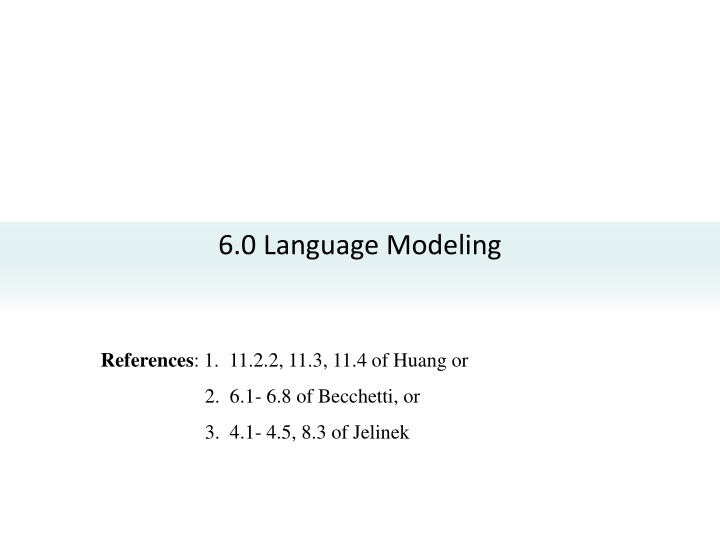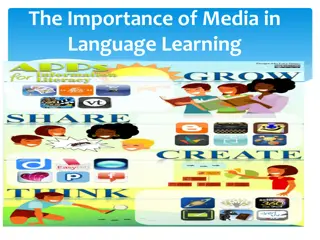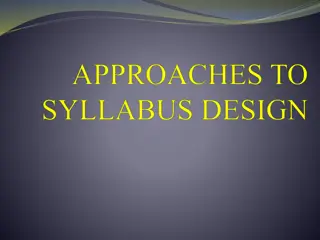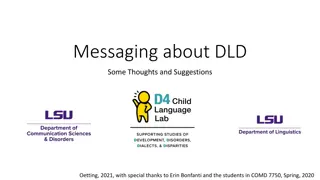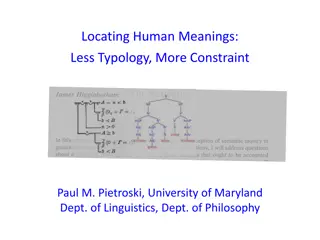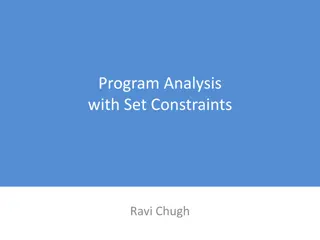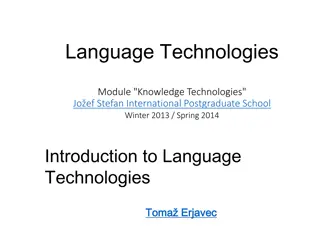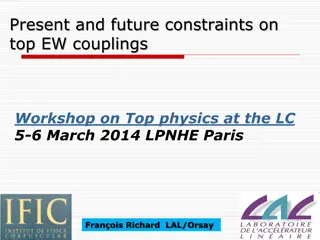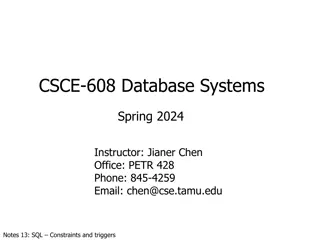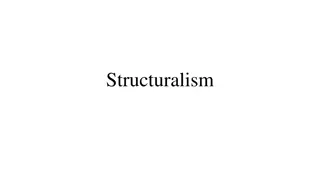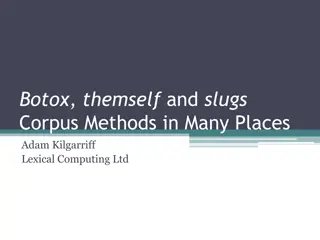Language Modeling: Providing Linguistic Constraints for Text Generation
Language modeling involves utilizing linguistic constraints to assist in selecting the correct words for generating text. This process is essential for various applications such as speech recognition and natural language processing. It entails analyzing probabilities of word sequences based on linguistic rules to enhance the accuracy and coherence of generated text. The concept of entropy and perplexity plays a crucial role in measuring uncertainty and predicting the next word in a given context. Evaluating perplexity helps assess the performance of language models by considering the average branching factor and the model's predictive capabilities. Additionally, source entropy estimation aids in understanding the information content per unit in a language source. These fundamental concepts are instrumental in developing efficient language models for improving text generation tasks.
Download Presentation

Please find below an Image/Link to download the presentation.
The content on the website is provided AS IS for your information and personal use only. It may not be sold, licensed, or shared on other websites without obtaining consent from the author.If you encounter any issues during the download, it is possible that the publisher has removed the file from their server.
You are allowed to download the files provided on this website for personal or commercial use, subject to the condition that they are used lawfully. All files are the property of their respective owners.
The content on the website is provided AS IS for your information and personal use only. It may not be sold, licensed, or shared on other websites without obtaining consent from the author.
E N D
Presentation Transcript
6.0 Language Modeling References: 1. 11.2.2, 11.3, 11.4 of Huang or 2. 6.1- 6.8 of Becchetti, or 3. 4.1- 4.5, 8.3 of Jelinek
Language Modeling: providing linguistic constraints to help the selection of correct words The computer is listening come list they tutor sunny t t Prob [the computer is listening] > Prob [they come tutor is list sunny] Prob [ ] > Prob [ ] 2
From Fundamentals of Information Theory Examples for Languages 0 H (S) log M Source of English text generation this course is about speech..... the random variable is the character 26*2+.....<64=26 H (S) < 6 bits (of information) per character the random variable is the word assume total number of words=30,000<215 H (S) < 15 bits (of information) per word Source of speech for Mandarin Chinese ..... the random variable is the syllable (including the tone) 1300 < 211 H (S) < 11 bits (of information) per syllable (including the tone) the random variable is the syllable (ignoring the tone) 400 < 29 H (S) < 9 bits (of information) per syllable (ignoring the tone) the random variable is the character 8,000 < 213 H (S) < 13 bits (of information) per character Comparison: speech , girl , computer S S 3
Entropy and Perplexity Entropy and Perplexity P ( Xi) P ( xi) x1 xM a b c . . . . . z A B C . . . . . Z 4
Entropy and Perplexity Uncertainty 5
Perplexity Perplexity of A Language Source S = (perplexity: ) ( p H ( S ) ( p x ) log x ) i i i = PP ( S ) 2 H ( S ) size of a virtual vocabulary in which all words (or units) are equally probable e.g. 1024 words each with probability H(S)= 10 bits (of information), PP(S)=1024 branching factor estimate for the language A Language Model assigning a probability P(wi|ci) for the next possible word wigiven a condition ci e.g. P(W=w1,w2,w3,w4....wn)=P(w1)P(w2|w1) P(wi|wi-2,wi-1) 1024, ?(??)=10 bits (of information) 1 n i=3 c2 ci c1=? A Test Corpus D of N sentences, with the i-th sentence Wihas ni words and total words ND D = [W1,W2,....,WN], Wi= w1,w2,w3,....wni = 1 i N = N n D i 6
Perplexity Perplexity of A Language Model P(wi|ci) with respect to a Test Corpus D H (P ; D)= , average of all log P(wj|cj) over the N 1 i 1 j D = = ( ) 1 n N i log P w c j j whole corpus D ( ) n 1 N j = i 1 N = , logarithm of geometric mean of P(wj|cj) pp (P ; D) =2H(P;D) log P w c D j j = 1 j average branching factor (in the sense of geometrical mean of reciprocals) e.g. P(W=w1w2...wn)=P(w1) P(w2|w1) P(w3|w1,w2) P(w4|w2,w3) P(w5|w3,w4) ..... 1 1 1 1 1 256 256 512 128 1024 1 1 1 1 1 1 1 n = 312 1024 512 256 128 256 the capabilities of the language model in predicting the next word given the linguistic constraints extracted from the training corpus the smaller the better, performance measure for a language model with respect to a test corpus a function of a language model P and text corpus D 7
Perplexity D Testing Corpus LM Language Model P (wi| ci) PP Training corpus Training Testing PP ( P D ) 8
An Perplexity Analysis Example with Respect to Different Subject Domains Domain-specific Language Models Trained with Domain Specific Corpus of Much Smaller Size very often Perform Better than a General Domain Model Training corpus: Internet news in 700 700 650 650 600 600 550 550 500 500 Chinese language perplexity perplexity 450 450 1 politics 2 congress 3 business 4 culture 5 sports 6 transportation 7 society 8 local 9 general(average) 58.1 M 19.6 M 2.7 M 8.9 M 4.3 M 2.1 M 1.6 M 10.8 M 8.1 M 400 400 350 350 300 300 250 250 1 2 3 4 5 6 7 8 9 0 general domain general domain domain specific domain specific Sports section gives the lowest perplexity even with very small training corpus 9
Perplexity KL Divergence or Cross-Entropy ) x ( q ) x ( p D i p ( x ) = i p ( x ) log 0 i i q ( x ) i Jensen s Inequality i p ( x ) log p ( x ) p ( x ) log q ( x ) i i i i Someone call this cross-entropy = X[p(x) q(x)] entropy when p(x) is incorrectly estimated as q(x) (leads to some entropy increase) The True Probabilities P(wi|ci) incorrectly estimated as P(wi|ci) by the language model x ( q log ) x ( p ) x ( q log N i 1 k = (averaging if p(xi) is known) (averaging by all samples) law of large numbers 1 N ) i = Nlim k i The Perplexity is a kind Cross-Entropy when the true statistical characteristics of the test corpus D is incorrectly estimated as p(wi|ci) by the language model H (P ; D) = X (D P) the larger the worse 10
Law of Large Numbers a1 a2 n1 n2 + ak nk N 1 n i i i = = i Ave a n a a p i i i i i N N 11
Smoothing of Language Models Data Sparseness many events never occur in the training data e.g. Prob [Jason immediately stands up]=0 because Prob [immediately| Jason]=0 smoothing: trying to assign some non-zero probabilities to all events even if they never occur in the training data Add-one Smoothing assuming all events occur once more than it actually does e.g. bigram N w N j V: total number of distinct words in the vocabulary ( ( + ) k j k j k j ( , ) ( , ) ( , ) 1 N w w k w w k , N w w , = = j k ( ) p w w + j k j ( ) ) N w w N w w V j 12
Smoothing : Unseen Events P(wi) P(wi|wi-1) P(wi|wi-2, wi-1) unigram bi-gram trigram 13
Smoothing of Language Models Back-off Smoothing ?(wi|wi-n+1, wi-n+2, wi-1)= P(wi|wi-n+1, wi-n+2, wi-1), if N(<wi-n+1, wi-1, wi>)>0 a(wi-n+1, wi-1) ?(wi|wi-n+2, wi-1), if N(<wi-n+1, wi-1, wi>)=0 , if ??> 0 ?? ? ?? 1 , if ??= 0 ??: n-gram ??: smoothed n-gram ??= back-off to lower-order if the count is zero, prob (you| see)>prob (thou| see) Interpolation Smoothing ?(wi|wi-n+1, wi-n+2, wi-1)=b(wi-n+1, wi-1)P(wi|wi-n+1, wi-1)+(1-b(wi-n+1, wi-1)) ?(wi|wi-n+2, wi-1) interpolated with lower-order model even for events with non-zero counts ??= ???+ 1 ? ?? 1 also useful for smoothing a special domain language model with a background model, or adapting a general domain language model to a special domain ? = ???+ 1 ? ?? 14
Smoothing of Language Models Good-Turing Smoothing Good-Turning Estimates: properly decreasing relative frequencies for observed events and allocate some frequencies to unseen events Assuming a total of K events {1,2,3...,k,.....K} number of observed occurrences for event k: n(k), N = K k = n ( k ) N: total number of observations, 1 nr: number of distinct events that occur r times (number of different events k such that n(k) = r) = r N r n r Good-Turing Estimates: total counts assigned to unseen events=n1 total occurrences for events having occurred r times: rnr (r+1)nr+1 an event occurring r times is assumed to have occurred r* times, * ) 1 r ( r + = n + r 1 r* =?1 n for r = 0 ( r ?0 = n + = + = * + ) 1 n ( ) 1 r n r r n N 1 r + 1 r r r n r r r r 15
Good-Turing event seen events unseen events 994 0 ?0 ?1 ?2 1 2 3 18 994 3 18 ?? r r+1 ??+1 An analogy: during fishing, getting each kind of fish is an event an example: n(1)=10, n(2)=3, n(3)=2, n(4)= n(5)= n(6)=1, N=18 prob (next fish got is of a new kind) = prob (those occurring only once) =18 3 16
Smoothing of Language Models Katz Smoothing large counts are reliable, so unchanged small counts are discounted, with total reduced counts assigned to unseen events, based on Good-Turing estimates r = = 0 1 ( r ) n d r n , dr: discount ratio for events with r times 1 r 1 r distribution of counts among unseen events based on next-lower-order model: back off an example for bigram: N (< wi-1,wi >) / N(wi) , r > r0 dr N (< wi-1,wi >) / N(wi) , r0 r > 0 a (wi-1,wi) P(wi) , r = 0 = P ( w w ) 1 i i a (wi-1,wi): such that the total counts equal to those assigned 17
Katz Smoothing event 0 ?0 ?0 1 (1 ?1) 2 (1 ?2) 3 (1 ?3) ?1 ?2 ?1= ??1 ??? ?=1 ?? ? ?3 ? ?0(1 ??0) ??0 ?0+ 1 ??0+1 unchanged ?0 ??0 18
Class-based Language Modeling Clustering Words with Similar Semantic/Grammatic Behavior into Classes e.g. John Marry street road dog cat saw found on a the He She campus drove rode car bus in father sister My park P(wi|wi-2, wi-1) P(wi|c(wi))P(c(wi)|c(wi-2), c(wi-1) ) c(wj): the class including wj Smoothing effect: back-off to classes when too few counts, classes complementing the lower order models parameter size reduced Limited Domain Applications: Rule-based Clustering by Human Knowledge e.g. Tell me all flights of from to on Eva Air Sunday United China Airline Taipei Los Angeles new items can be easily added without training data General Domain Applications: Data-driven Clustering (probably aided by rule-based knowledge) 19
Class-based Language Modeling Data-driven Word Clustering Algorithm Examples Example 1: initially each word belongs to a different cluster in each iteration a pair of clusters was identified and merged into a cluster which minimizes the overall perplexity stops when no further (significant) reduction in perplexity can be achieved Reference: Cluster-based N-gram Models of Natural Language , Computational Linguistics, 1992 (4), pp. 467-479 Example 2: Prob [W= w1w2w3....wn]= Prob(wi|w1,w2....wi-1)= Prob(wi|hi) hi: w1,w2,...wi-1, history of wi clustering the histories into classes by decision trees (CART) developing a question set, entropy as a criterion may include both grammatic and statistical knowledge, both local and long-distance relationship Reference: A Tree-based Statistical Language Model for Natural Language Speech Recognition , IEEE Trans. Acoustics, Speech and Signal Processing, 1989, 37 (7), pp. 1001-1008 n n i=1 i=1 20
An Example Class-based Chinese Language Model A Three-stage Hierarchical Word Classification Algorithm stage 1 : classification by 198 POS features (syntactic & semantic) each word belonging to one class only each class characterized by a set of POS s stage 2 : further classification with data-driven approaches stage 3 : final merging with data-driven approaches all words ..... ..... ..... ..... ..... (car) (take) (ride) (ride) POS feature j POS feature i (bus) (train) (airplane) ....... ... ... ... ... ... ... ... (drive) (steer) ..... ..... ..... ..... rarely used words classified by human knowledge both data-driven and human-knowledge-driven 21
POS features ( _ , _ , _ , _ . . . ) Data-driven Approach Example 22
Structural Features of Chinese Language Almost Each Character with Its Own Meaning, thus Playing Some Linguistic Role Independently No Natural Word Boundaries in a Chinese Sentence word segmentation not unique words not well defined commonly accepted lexicon not existing Open ( Essentially Unlimited ) Vocabulary with Flexible Wording Structure new words easily created everyday (electricity)+ (brain) (computer) long word arbitrarily abbreviated (Taiwan University) name/title (former President T.H. Lee) unlimited number of compound words (high) + (speed) + (highway) (freeway) Difficult for Word-based Approaches Popularly Used in Alphabetic Languages serious out-of-vocabulary(OOV) problem 23
Word-based and Character-based Chinese Language Models Word-based and Class-based Language Modeling words are the primary building blocks of sentences more information may be added lexicon plays the key role flexible wording structure makes it difficult to have a good enough lexicon accurate word segmentation needed for training corpus serious out-of -vocabulary(OOV) problem in many cases all characters included as mono-character words Character-based Language Modeling avoiding the difficult problem of flexible wording structure and undefined word boundaries relatively weak without word-level information higher order N-gram needed for good performance, which is relatively difficult to realize Integration of Class-based/Word-based/Character-based Models word-based models are more precise for frequently used words back-off to class-based models for events with inadequate counts each single word is a class if frequent enough character-based models offer flexibility for wording structure 24
Segment Pattern Lexicon for Chinese An Example Approach Segment Patterns Replacing the Words in the Lexicon segments of a few characters often appear together : one or a few words regardless of the flexible wording structure automatically extracted from the training corpus (or network information) statistically including all important patterns by minimizing the perplexity Advantages bypassing the problem that the word is not well-defined new words or special phrases can be automatically included as long as they appear frequently in the corpus (or network information) can construct multiple lexicons for different task domains as long as the corpora are given(or available via the network) 25
Example Segment Patterns Extracted from Network News Outside of A Standard Lexicon Patterns with 2 Characters Patterns with 3 Characters Patterns with 4 Characters 26
Word/Segment Pattern Segmentation Samples With A Standard Lexicon With Extracted Segment Pattern Percentage of Patterns outside of the Standard Lexicon : 28% 27
